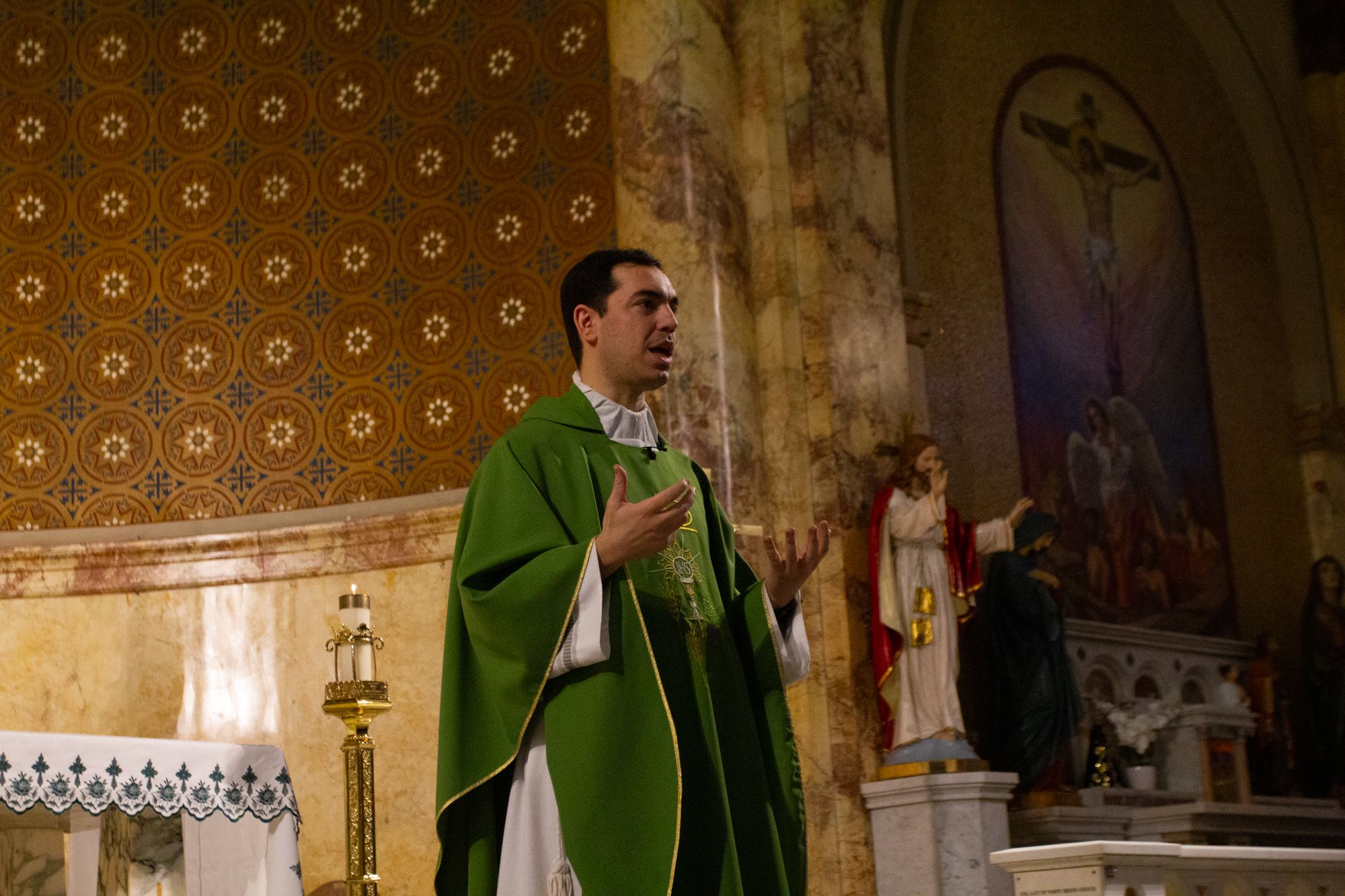
Fr. Luigi Portarulo during the Sunday Mass’s homily at Our Lady of Pompeii Church. (Credit Ella Napack)
It was late on a Thursday evening in December. The technicians had been working all day in the half-light of the empty church. “Father Luigi, we have finished if you want to see it,” one of them said.
Father Luigi Portarulo, 36, is the pastor of Our Lady of Pompeii Catholic church in Greenwich Village. He is the only Italian-born priest in Manhattan, from Bernalda, in the Basilicata region in southern Italy.
He quickly approached the large installation at the entrance of the church with a spring in his step. “All right, let me see,” he said.
In a crescendo of light and music, a small town in Basilicata took shape in the sacred silence of the church. This year, Our Lady of Pompeii hosted a Nativity scene inspired by the landscapes and traditions of the Basilicata, crafted by the artist Francesco Artese with over 120 characters. Portarulo brought a piece of his land to the heart of Manhattan.
“Mamma mia, how beautiful,” he said with a smile.
Portarulo prepared this moment for months.
Every pew was filled at the Mass for the Feast of the Immaculate Conception, and people stood at the sides and back. The majority of the faithful who crowded the church were Italians. Among them were many dignitaries from Congress, the mayor’s office and the United Nations.
“It was a massive event, almost like something from the Vatican,” Portarulo said later.
Nothing like what happened the year before, when there was no Nativity scene at all. “It’s something I’ve desired a lot,” he said.
Portarulo arrived in New York in November 2022, in response to the request of Father Angelo Plodari, the former pastor of Our Lady of Pompeii. The parish was short-handed and needed another religious leader. Plodari, serving both as parish pastor and provincial head of the Congregation of Scalabrinian priests, initially invited Portarulo just to assist.
When asked Plodari if he had called Portarulo to New York, he said with a smile, “I think God called him.”
Plodari continued: “He came to New York on vacation, stopped by the parish, concelebrated with me, and between jokes, I asked him: ‘Why don’t you have a different experience from Italian reality?’ and now Father Luigi is putting us into gear to revive the community, with his many experiences and abilities.”
Plodari, in his 40s, went on sabbatical in July, and Portarulo assumed the role of pastor at Our Lady of Pompeii.
Although Portarulo is from Basilicata, he spent most of his life, 23 years, in the Vatican. When he was a child, his grandmother Cosima introduced him to the Catholic church.
“Nobody ever explained the Gospel to me as well as my grandma did, despite my extensive studies in theology and the fact that she could neither read nor write,” he said.
Every Sunday, they went to Mater Ecclesiae Church in Bernalda, a town in the Southern Italian region of Basilicata and placed a coin at the statues of Saints Cosmos and Damian, and prepared for his service as an altar boy.
“I loved being an altar boy. My vocation was born that way,” he said, thinking about those Sunday mornings with his grandmother.
During the hot July of 1999, when he was 12, Portarulo, bored, was skimming through a Catholic magazine he found on the table of the home where he lived with his parents. He was fascinated by an announcement. “We are looking for altar boys in St. Peter’s Basilica for the Great Jubilee of 2000, to serve the Pope,” it said.
“I took the newspaper and went to my mom and told her, ‘I want to go to be an altar boy in Rome,’” he said. He bothered his parents so much with this desire that his mother, Enza, said, “All right, we’ll take you to Rome so you can see how far it is.”
After six hours in their Fiat Uno in the middle of the summer, without air conditioning, they arrived in Rome. They met the priest in charge of the project, and Portarulo immediately decided to convince his parents to let him participate and move to Rome.
For Portarulo, it was an extraordinary experience. Every Sunday, he served as an altar boy for Pope John Paul II and received communion directly from him. At the end of the Jubilee, he didn’t want to leave the Vatican. He attended the pre-seminary there during middle school and high school, where he said he got a better education than he would have gotten in his hometown. “It might have been just a calling. A 12-year-old boy there by himself. I was driven by something,” he said.
He had the chance to take part in historic events and meet the most influential figures in the Catholic church.
“I had a special notebook for dedications made by bishops and cardinals.” he said.
During his formative years, he participated in both the Great Jubilee of 2000 and the Jubilee of Mercy in 2015. He took part in one by serving and another by reading at the opening and closing of the Holy Door at St Peter’s Basilica. He entered carrying the candle during the conclave that elected Pope Benedict XVI, along with all 120 cardinals, and he served at the funeral of Pope John Paul II, which was led by Cardinal Joseph Ratzinger
“I lived through history without fully comprehending its magnitude,” he said.
A few days after turning 25, he was ordained a priest and served in the Vatican. Cardinal Angelo Comastri asked him to become a teacher, vice-rector and treasurer of the seminary.
Portarulo attended as many events as possible to meet new people. He officiated weddings for football players, singers and baptized the children of famous Italian actors.
“Today, the priest must engage with people in their environments,” Portarulo said.
Matteo Avigni, an Italian-born parish member, described Portarulo as a religious leader who brings people together.
“He is a very lively character who has greatly reinvigorated the parish community,” Avigni said. “He proposes many activities for people to come together: game nights, watching sports together, catechism. He has managed to gather a lot of people around the parish, perhaps even through non-traditional means like sports.”
After Portarulo blessed the Nativity scene at the end of Mass, the celebration continued in the parish basement, the crowd enjoying Italian delicacies donated by many local Italian businesses. Restaurants N.28 and Kesté brought pizza, the De Cecco company had their pasta cooked by chefs, and other businesses provided wine, arancini and ice cream. As people lined up to taste the pasta all’amatriciana, Portarulo introduced himself to those he didn’t know, saying, “It’s all so good, isn’t it?”
“You can sense his excitement in meeting influential people and doing these big events,” said Costanza Penna, a Ph.D. candidate in philosophy at University of Turin who is spending a semester at Columbia University. “But what truly drives him to do these things is his concern for people’s hearts, which is always his focal point in discussing them.”
About the author(s)
Tommaso Baronio is a Master of Science student at the Columbia Journalism School, and previously worked at La Verità and Pluralia Magazine as an editor.



